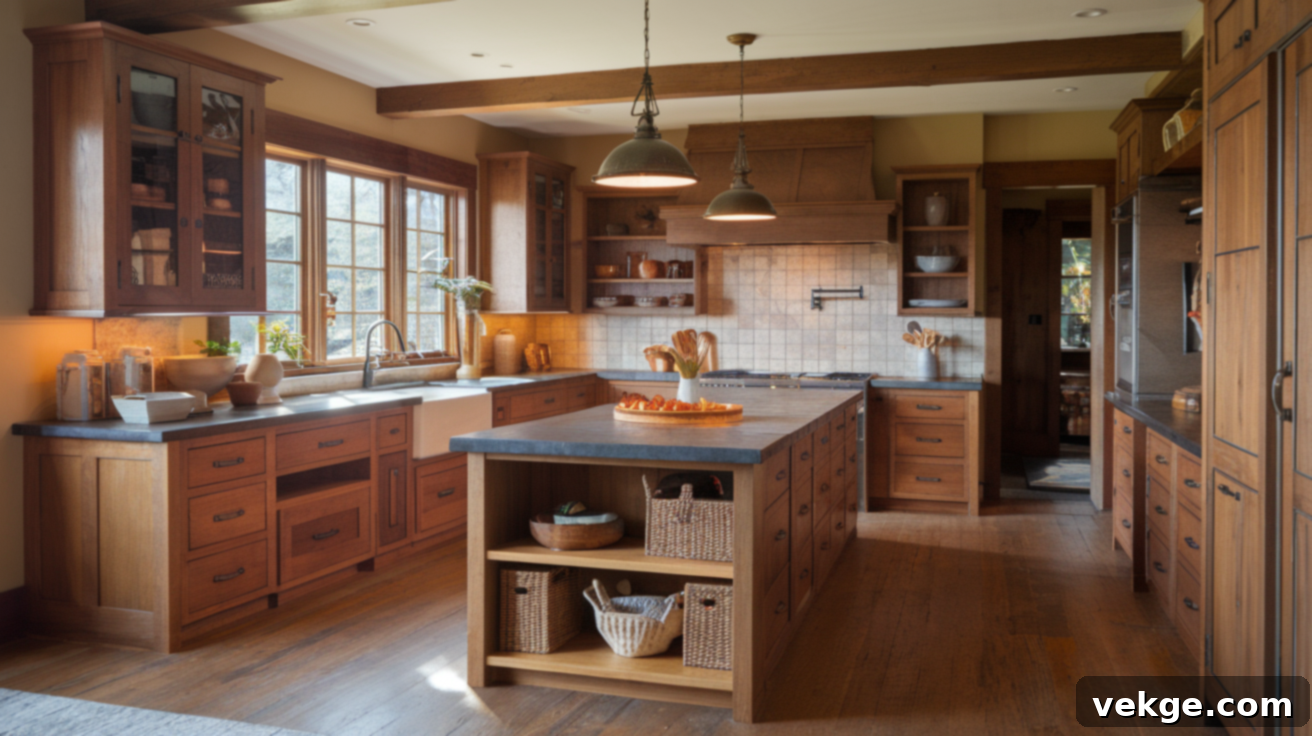Timeless Elegance: Discovering the Beauty and Functionality of Craftsman Kitchens
Are you searching for a kitchen style that perfectly blends beauty with practicality? A Craftsman kitchen might be the ideal choice for your home. This enduring style has captivated homeowners for generations, celebrated for its unique ability to combine aesthetic appeal with high functionality.
At its heart, Craftsman kitchen design emphasizes natural materials, superior craftsmanship, and intelligent layouts. It uses authentic wood, genuine stone, and clean, simple lines to forge a warm, inviting space that’s perfect for both everyday cooking and cherished family gatherings.
In this comprehensive guide, we’ll delve into the distinctive characteristics that make a Craftsman kitchen truly special. You’ll learn how to select the best materials, explore a variety of design ideas, and discover practical tips to bring this beloved style to life in your own home. Whether you’re drawn to a traditional, classic design or prefer a fresh, modern interpretation of the Craftsman aesthetic, this guide provides all the inspiration and information you need.
What Defines a Craftsman Kitchen? Understanding Its Enduring Appeal
A Craftsman kitchen is more than just a style; it’s a philosophy that prioritizes quality, authentic materials, and handcrafted details. Originating from the influential Arts and Crafts movement of the early 20th century, this design approach was a direct response to the era’s mass production, advocating for a return to skilled artistry and genuine materials. The result is a kitchen design that feels robust, welcoming, and deeply personal.
These kitchens truly stand out because they seamlessly integrate function with beauty. They exude a warm, cozy ambiance while remaining exceptionally practical for daily culinary tasks and serving as the heart of family life. Unlike fleeting trends, Craftsman kitchens offer a sense of permanence and timelessness, appealing to those who value durability and understated elegance.
Characterized by abundant wood elements, straightforward lines, and bespoke touches, each Craftsman kitchen possesses its own unique charm. Homeowners who opt for this style are typically seeking a kitchen that not only looks magnificent but is also built to last, reflecting a commitment to enduring quality and thoughtful design.
Key Features and Elements of the Craftsman Kitchen Style
The true essence of a Craftsman kitchen lies in its personal touch and meticulous construction. Every component is carefully chosen and integrated, working in harmony to create a space that is both highly functional and visually pleasing. Here are the core features that define this iconic style:
- Rich Wood Finishes and Cabinetry: Wood is undeniably the star of any Craftsman kitchen. Warm, inviting tones like oak, maple, and cherry are frequently used, creating a cozy and grounded atmosphere. The wood often features a natural, subtly matte finish that proudly showcases its inherent grain and texture, emphasizing the beauty of real materials. Quarter-sawn oak, with its distinctive ray flecks, is a particularly prized choice for its unique visual appeal and stability.
- Thoughtful Cabinet Design: Craftsman cabinets are known for their simple yet robust construction, often featuring flat panels or classic Shaker styles. Detailed woodwork, such as exposed joinery or subtly tapered stiles, adds a touch of sophistication without being overly ornate. Glass doors are a popular option, allowing homeowners to display cherished dishes or artisanal items, adding depth and lightness to the cabinetry. Integrated plate racks and open shelving can further enhance both display and accessibility.
- Integrated Built-in Storage Solutions: Maximizing space and functionality is paramount in Craftsman design. This style excels at incorporating clever, custom-built storage. Think pull-out drawers designed for specific items, hidden nooks for small appliances, and cabinets crafted to fit the exact dimensions of the space. Built-in benches with under-seat storage, window seats, and even small, walk-in pantries are common elements that enhance organization and reduce clutter, all while maintaining the kitchen’s cohesive aesthetic.
- Earthy and Natural Color Palettes: The color scheme in a Craftsman kitchen typically draws inspiration from nature. Hues of warm browns, deep greens, muted golds, and creamy whites are common. These colors complement the natural wood tones and create a serene, grounded environment. Accent colors might include deeper blues or rich reds, often used sparingly to highlight architectural features or handcrafted tiles.
- Durable Countertops: Materials like granite, soapstone, and quartz are favored for their durability and natural beauty. Soapstone, in particular, is a classic choice, known for its soft, dark appearance and ability to develop a unique patina over time. These materials not only provide resilient work surfaces but also contribute to the authentic, high-quality feel of the kitchen.
- Artisan Hardware and Fixtures: Hardware is often understated but robust, reflecting the handmade ethos. Bronze, antique brass, oil-rubbed bronze, and wrought iron are common choices for cabinet pulls and hinges. Lighting fixtures often feature stained glass, hammered metal, or simple, geometric shapes, providing both ample illumination and a strong stylistic statement.
Many homes across the country still showcase these beautiful kitchens, and numerous companies continue the tradition of crafting and renovating spaces in the Craftsman style, upholding its legacy of quality for decades.
Inspiring Craftsman Kitchen Design Ideas for Every Home
Craftsman kitchens are celebrated for their ability to infuse warmth and distinctive character into homes, thanks to the thoughtful selection of quality materials and the application of skilled craftsmanship. These kitchens truly excel at combining functionality with beauty, resulting in spaces that are not only practical for everyday family life but also visually stunning and inviting.
Classic Craftsman Kitchens: Rooted in Tradition
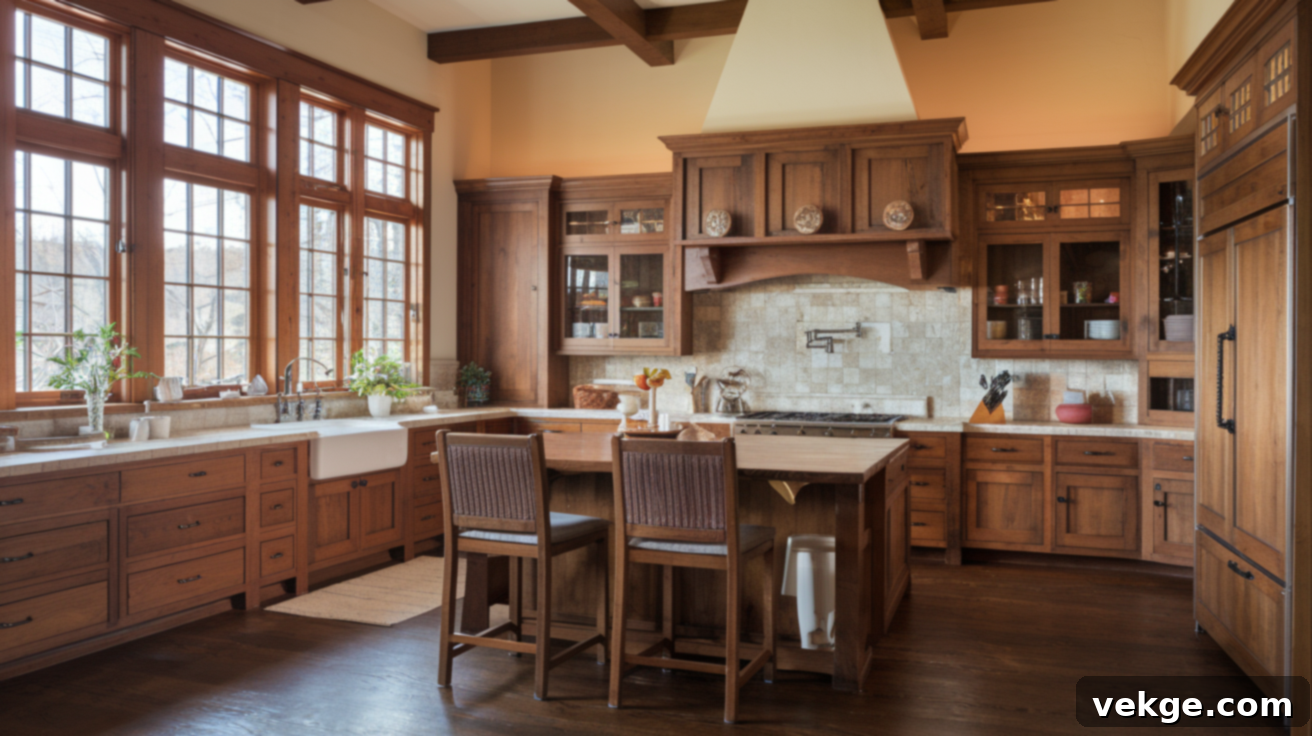
Traditional Craftsman kitchens are characterized by rich, natural wood cabinets, often in oak or maple, featuring simple, clean lines that form the foundational backbone of these spaces. The visible detailing in the woodwork proudly displays the craftsmanship that gives this style its name, while practical, ergonomic layouts ensure that cooking and family gatherings are comfortable and efficient.
Natural stone or handmade ceramic tile backsplashes, typically in warm earth tones, beautifully complement the wood elements. Mission-style cabinet doors, with their characteristic flat panels and minimal ornamentation, further enhance the authentic, historical look. Built-in bench seating, often found in a cozy breakfast nook, offers both comfort and additional storage. Warm, diffused pendant lighting or Sconce fixtures provide ambient illumination, and smart, integrated storage solutions ensure these kitchens are both cozy and highly functional. The color palette predominantly features warm and natural browns, tans, greens, and soft yellows, creating a harmonious and inviting atmosphere.
Modern Craftsman Kitchen Ideas: A Contemporary Twist
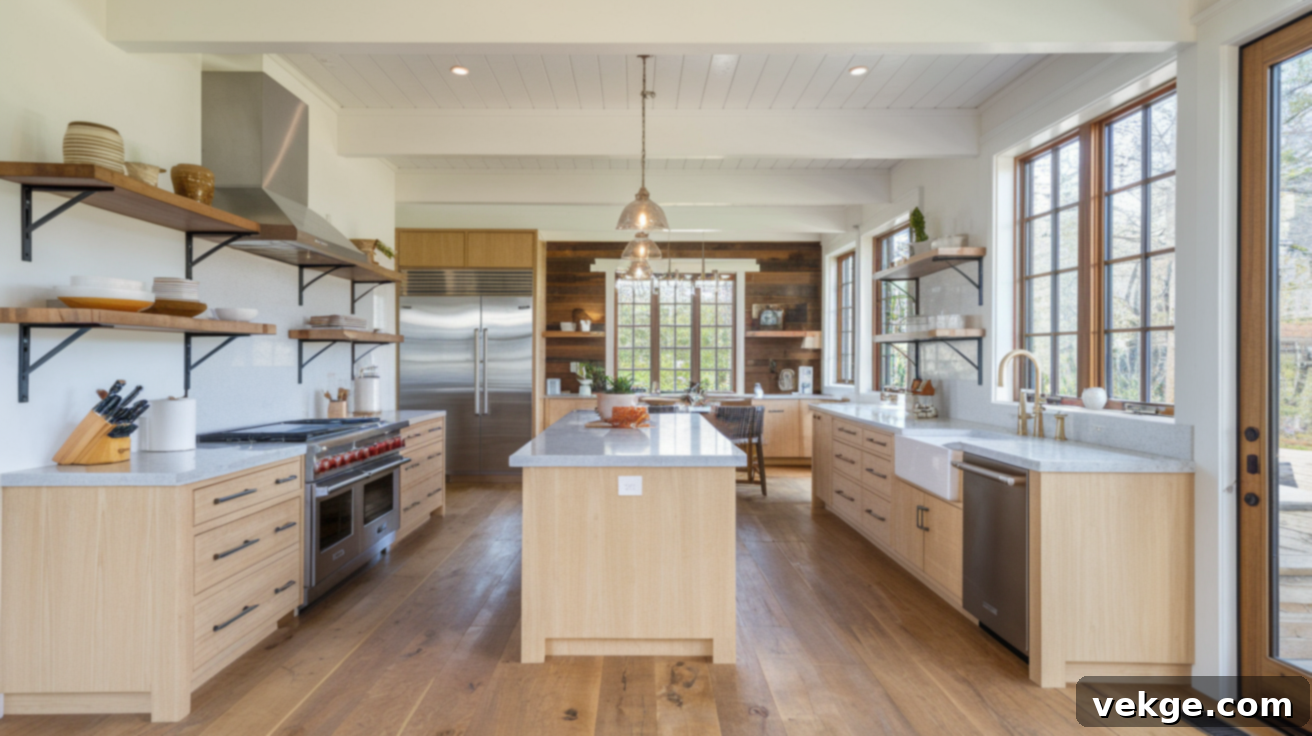
Today’s modern Craftsman kitchens masterfully retain the best elements of traditional design while incorporating fresh, contemporary touches. Open floor plans are common, seamlessly connecting the kitchen to dining and living areas, transforming it into a vibrant social hub. Larger windows and glass doors are often used to maximize the influx of natural light, creating a brighter and more expansive feel.
Stainless steel appliances are artfully integrated with wood cabinetry, which might feature lighter wood tones or painted finishes (such as soft grays or whites) to achieve a more contemporary aesthetic. Countertops are often quartz or granite, chosen for their durability, aesthetic appeal, and easier maintenance. Open shelving is frequently utilized to display dishes and decorative items, simultaneously adding visual space and a touch of personalization. Updated lighting fixtures maintain simple, clean designs but often feature contemporary shapes and materials. Light-colored subway tile backsplashes provide a classic yet fresh look, and large kitchen islands offer extensive workspace, additional storage, and casual seating, making them central to the modern kitchen experience.
Farmhouse-Inspired Craftsman Kitchen Design: Rustic Charm Meets Craftsmanship
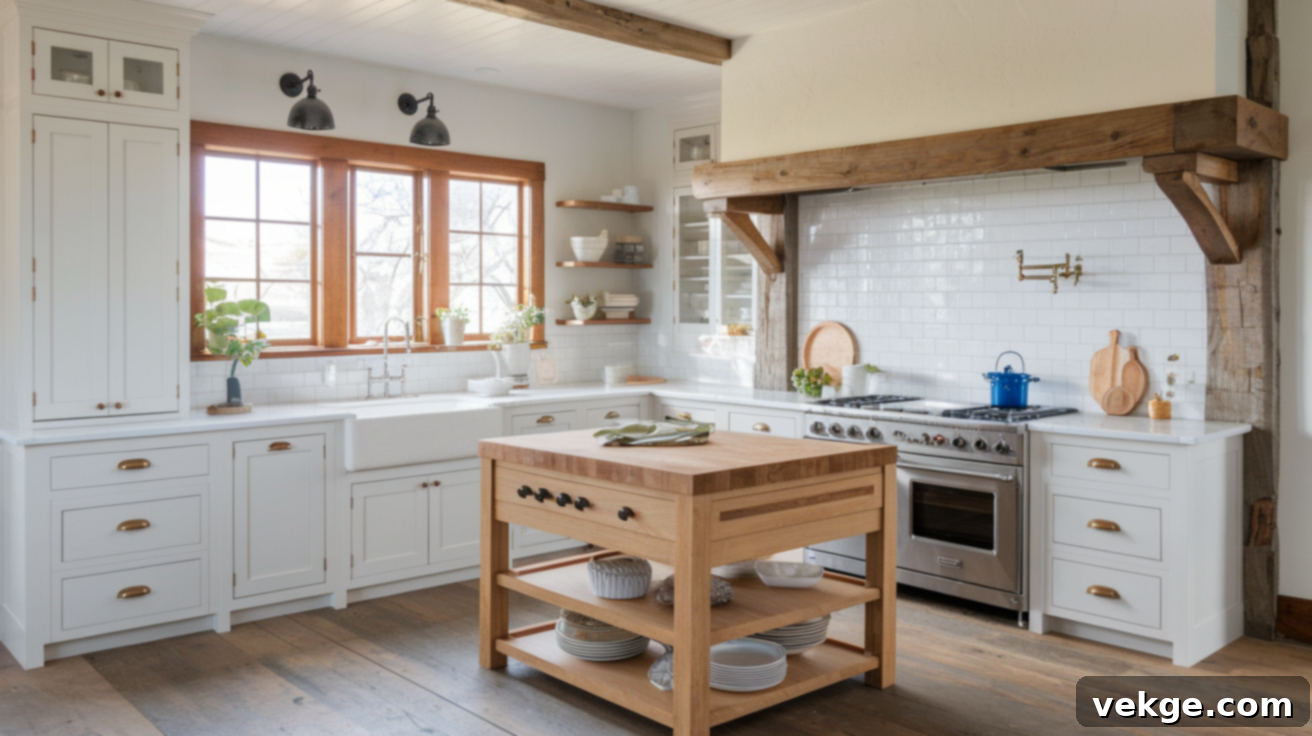
Farmhouse-inspired Craftsman kitchens beautifully merge rustic country charm with the inherent reliability and quality of Craftsman construction. Key features include classic Shaker-style cabinets, which offer clean lines and timeless appeal, paired with iconic deep farmhouse sinks. Wooden accents, such as reclaimed wood open shelving, butcher block countertops, or exposed ceiling beams, create a wonderfully homey and welcoming atmosphere.
The color palette in these kitchens tends to be light and airy, featuring crisp whites, soft grays, and natural wood tones that enhance the bright, open feel. Vintage-style hardware, often in black iron or brushed brass, adds subtle character and a touch of antique charm. Structural interest is often provided by wooden beams across ceilings or framing prominent features like kitchen islands, reinforcing the rustic aesthetic while maintaining Craftsman quality. These spaces are designed to feel exceptionally welcoming and comfortable, perfect for large families and frequent entertaining, all while upholding the robust quality standards of Craftsman design.
Minimalist Craftsman Kitchen Design: Simplicity with Substance
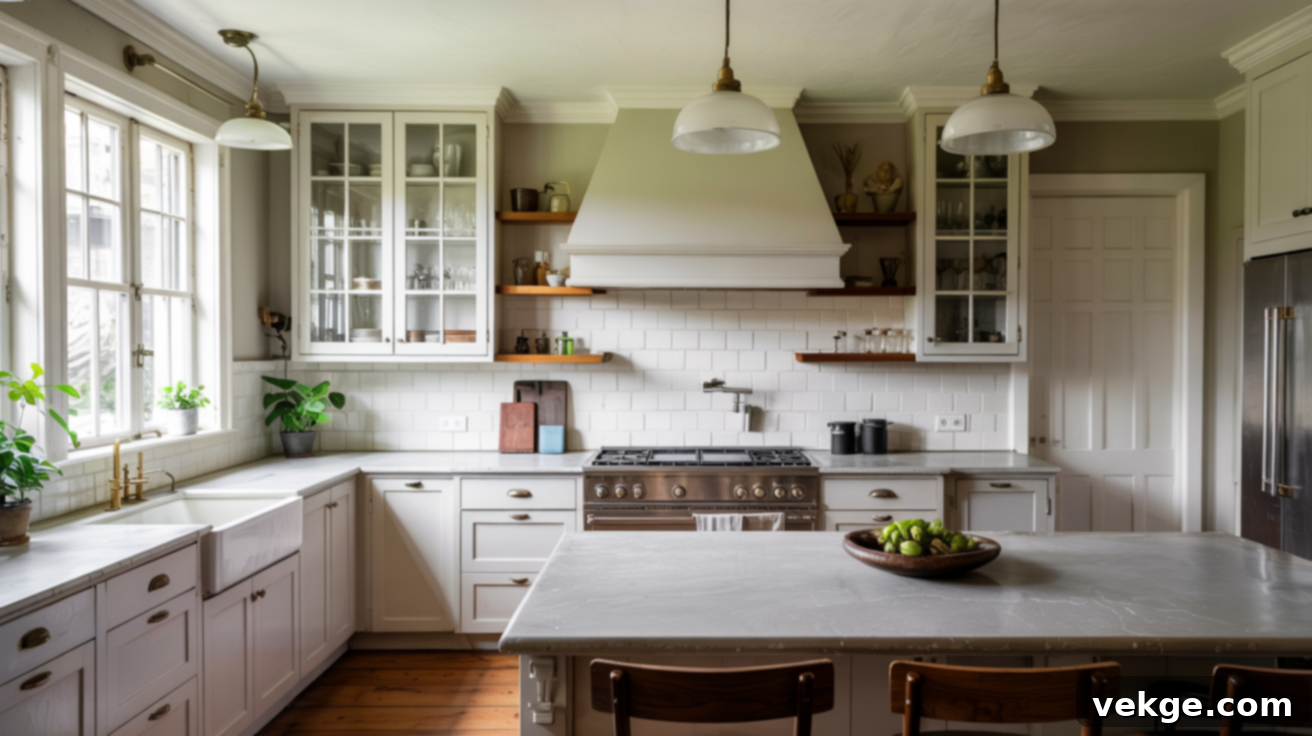
The minimalist Craftsman style meticulously preserves the core elements of quality craftsmanship while intentionally stripping away any superfluous ornamentation. Cabinets are designed with exceptionally clean lines and are typically presented in neutral colors such as white, gray, or natural, light wood tones. Simple, uncluttered countertops, often crafted from granite or concrete, are chosen for their understated elegance and absence of busy patterns.
Glass cabinet doors and judiciously placed open shelving are used to reduce visual weight and enhance the feeling of spaciousness, allowing the quality of the materials themselves to be the focal point. Appliances are frequently integrated or hidden behind cabinet panels to create a smooth, seamless aesthetic. Lighting fixtures maintain basic, geometric shapes without any fancy or elaborate details, ensuring they contribute to the calm, uncluttered environment. This minimalist approach deeply values premium materials and meticulous construction, prioritizing functionality and serene beauty over decorative extras, resulting in tranquil spaces with a truly timeless appeal.
Eclectic Craftsman Kitchen Design: Personal Expression and Heritage
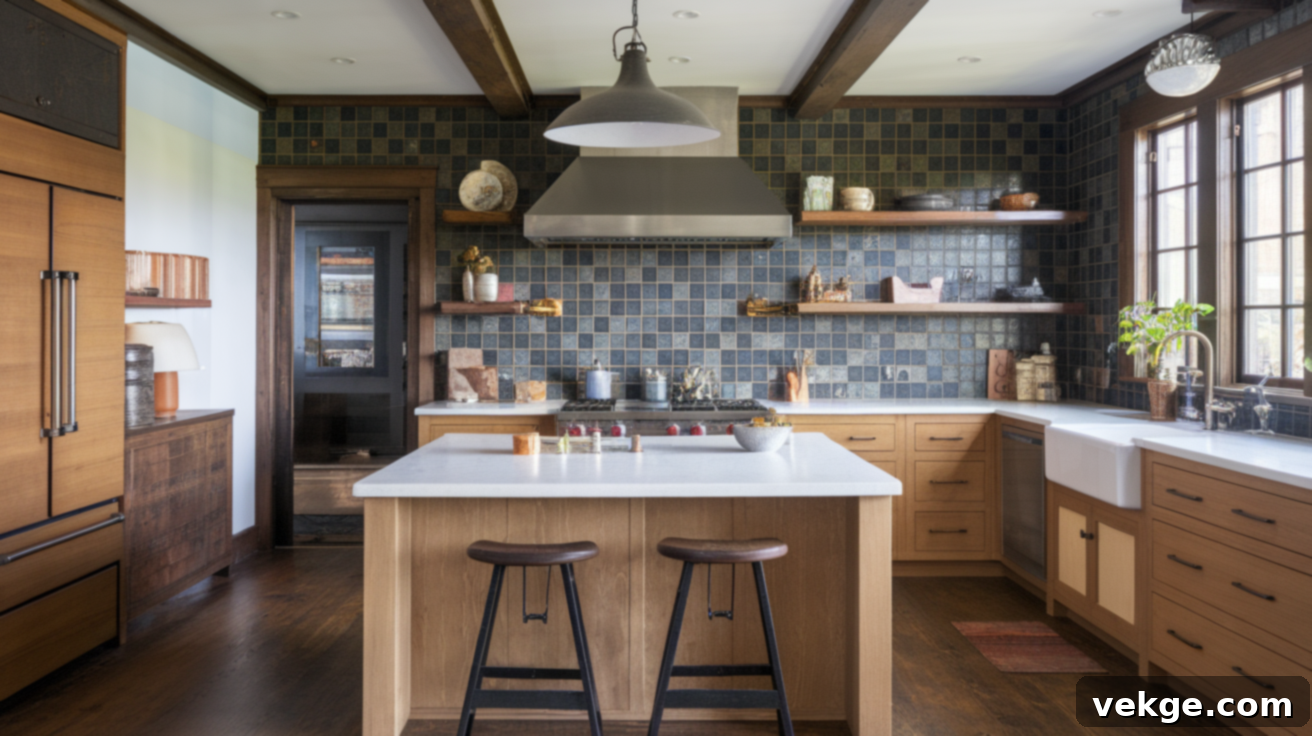
Eclectic Craftsman kitchens offer a vibrant blend of traditional Craftsman elements with unique, personal touches that reflect the homeowner’s individuality. This style encourages experimentation, where different wood types might be combined to create visual interest and texture, and unique, handcrafted tiles can add a burst of personality and artistic flair. Bold color choices might deviate from standard Craftsman palettes, used strategically to highlight specific areas or features, all while maintaining the core structural integrity and quality of the Craftsman style.
For example, classic Shaker cabinets could be paired with a brightly colored or intricately patterned backsplash. Repurposed or antique materials, such as a vintage island or salvaged lighting fixtures, can introduce a sense of history and unique character. Personal items, ranging from handmade pottery collections to custom-designed lighting, are proudly displayed, making these kitchens truly individual spaces that celebrate personal expression while deeply honoring their Craftsman roots. This style is perfect for those who appreciate the quality of Craftsman design but want to infuse it with their own narrative and artistic vision.
Choosing the Right Materials for Your Craftsman Kitchen
The selection of materials is absolutely crucial in defining the character and durability of a Craftsman kitchen. The right materials not only enhance the aesthetic appeal but also ensure the kitchen stands the test of time, performing beautifully for many years. Let’s explore the finest choices for your kitchen, focusing on authenticity and longevity.
Best Woods for Cabinets, Furniture, and Surfaces
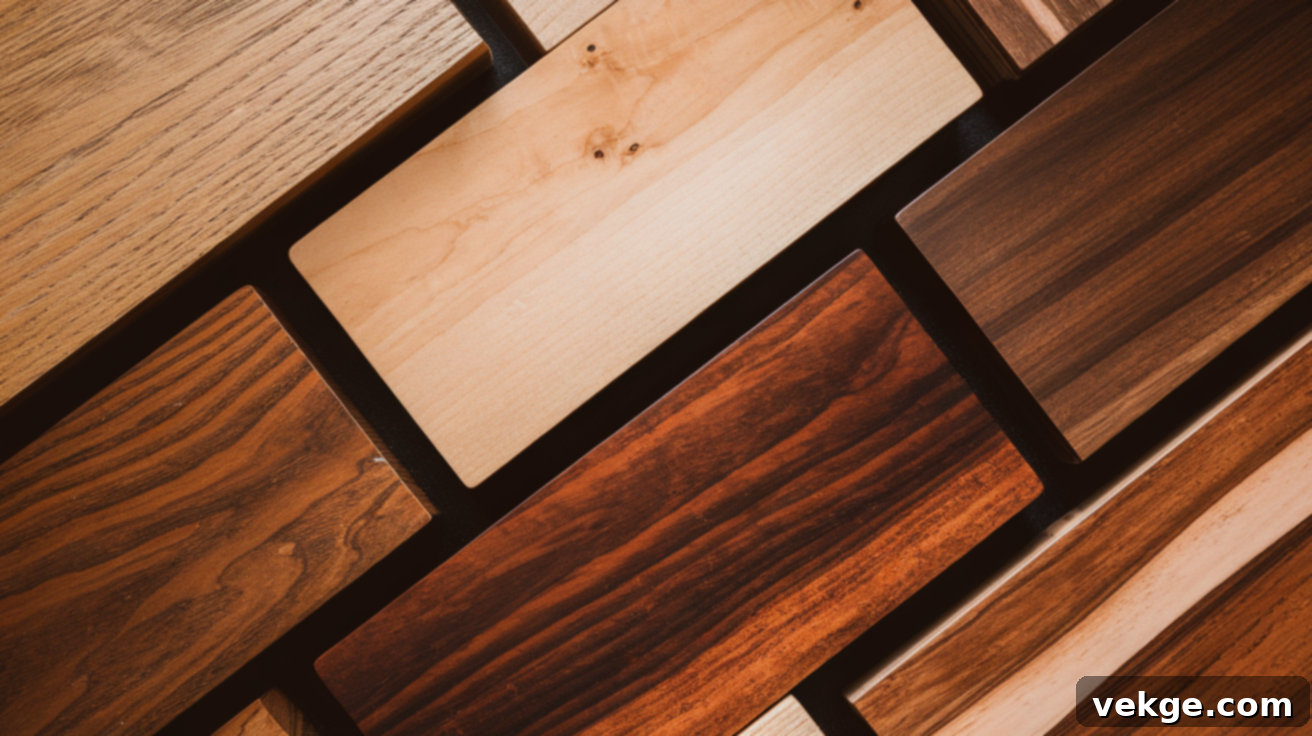
Wood is the cornerstone material in any Craftsman kitchen. The type of wood you select profoundly influences the overall tone and feel of the entire room, offering distinct characteristics and visual appeal.
| Wood Type | Characteristics | Best For |
|---|---|---|
| Oak | Known for its prominent and strong grain pattern, which adds significant character and a rustic, authentic feel. Very durable. | Cabinet fronts, sturdy flooring, built-in shelving. |
| Maple | Offers a smoother, finer grain pattern and a naturally warm, light hue. Its even texture makes it versatile for various finishes. | Cabinets, kitchen islands, butcher block countertops. |
| Cherry | Features a fine, uniform grain and deepens beautifully in color to a rich reddish-brown as it ages, developing a stunning patina. | Statement pieces, bespoke built-ins, elegant furniture. |
| Hickory | Distinguished by its dramatic variations in color, blending light and dark tones. It’s exceptionally hard and durable, perfect for high-traffic areas. | Rustic-look cabinets, accent areas, flooring in busy kitchens. |
| Mahogany | A luxurious option, mahogany has a rich, reddish-brown color and a fine, straight grain. It’s highly durable and lends a sophisticated touch. | High-end cabinets, custom furniture pieces, decorative trim. |
When selecting finishes for your wood, prioritize options that truly celebrate and enhance the wood’s inherent beauty and grain structure:
- Clear Coats or Light Stains: These finishes allow the natural color and intricate grain of the wood to shine through, maintaining an authentic and organic look.
- Oil-Based Finishes: Penetrating oil finishes nourish the wood, bringing out its natural depth, richness, and warmth while offering a soft, matte luster.
- Quarter-Sawn Wood: While more costly, quarter-sawn wood (especially oak) reveals unique, perpendicular grain patterns (like “ray fleck”) that add significant visual interest and stability, embodying true Craftsman artistry.
Stone and Tile Options for Craftsman Kitchens
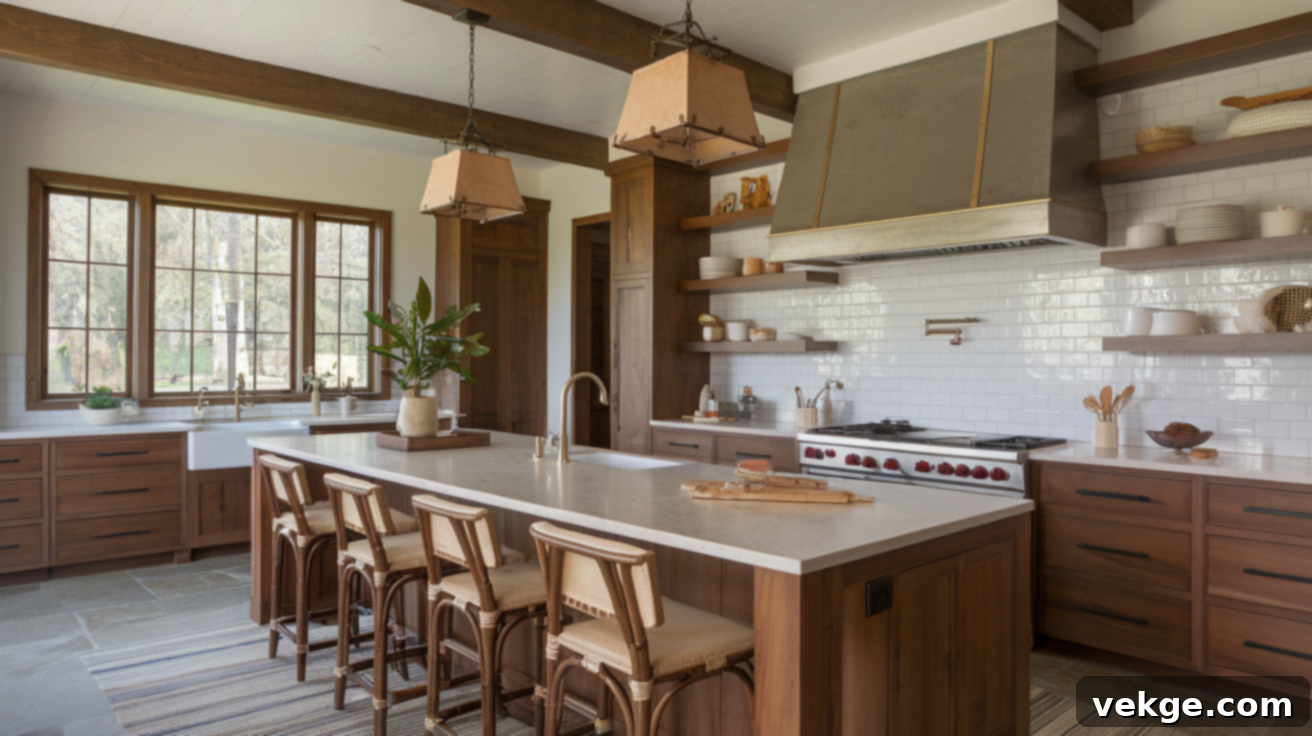
For countertops and backsplashes, the Craftsman style demands materials that are both visually appealing and highly practical, capable of withstanding the rigors of a busy kitchen.
| Material Type | Options & Characteristics | Key Benefits for Craftsman Style |
|---|---|---|
| Natural Stone Countertops | Granite: Available in a wide array of earth tones, from deep greens and browns to warm grays and creams. Each slab is unique. | Extremely durable, highly heat-resistant, and scratch-resistant. Provides a natural, robust feel fitting for Craftsman design. |
| Soapstone: A softer, darker stone that is non-porous and incredibly dense. It develops a beautiful, rich patina over time, adding character. | Authentic dark look, naturally resistant to stains and bacteria. Easy to maintain, ages gracefully. | |
| Quartz (Engineered Stone): Composed of natural quartz particles mixed with resins, offering consistent patterns and a wide color range. | Very durable, non-porous, and low-maintenance. A practical and often more budget-friendly alternative to natural stone. | |
| Tile Backsplashes & Flooring | Subway Tile: A classic choice, particularly the 3×6 inch size, reminiscent of early 1900s homes. Available in ceramic or porcelain. | Timeless, clean, and versatile. Can be laid in various patterns (offset, stack bond) to suit different aesthetics. |
| Handmade Ceramic Tiles: Offers unique variations in color, texture, and glazing, providing a truly bespoke, artisan feel. | Adds a distinct handmade touch and character, aligning perfectly with the Arts and Crafts ethos. Can feature subtle patterns or reliefs. | |
| Floor Tiles: Durable options like ceramic, porcelain, or natural slate for flooring. Often chosen in earthy, muted tones. | Water-resistant, easy to clean, and extremely hard-wearing, ideal for high-traffic kitchen areas. Can complement wood flooring in adjacent rooms. | |
| Glass Tiles: While more modern, certain matte or earthy-toned glass tiles can add subtle reflection and depth to backsplashes. | Adds a touch of contemporary elegance, can brighten spaces, and comes in various colors. |
When planning your Craftsman kitchen, working with experienced designers and builders is invaluable. They can help you select the ideal combination of materials to create a kitchen that is both stunning and exceptionally functional, drawing on years of expertise to bring your vision to life.
Crafting a Functional and Beautiful Craftsman Kitchen
A truly successful Craftsman kitchen must strike a perfect balance between aesthetic appeal and practical utility. The most admired kitchens effortlessly make cooking and daily tasks easy, all while maintaining their distinctive and beautiful style. Here’s how you can design and create a kitchen that operates seamlessly and remains faithful to the timeless Craftsman aesthetic.
Maximizing Storage in Craftsman Kitchens with Smart Solutions
Efficient storage is a cornerstone of any well-designed kitchen, and in a Craftsman space, storage solutions should not only be highly practical but also beautifully integrated into the overall style. The goal is to keep essentials handy while maintaining an uncluttered, harmonious look.
- Custom Cabinets to the Ceiling: Make the most of your vertical space by installing tall, custom-built cabinets that extend all the way to the ceiling. The upper sections are ideal for storing seasonal items or rarely used appliances, keeping them out of sight but accessible.
- Integrated Built-in Pantry: A custom-designed pantry, clad with cabinet-matched doors, offers a cohesive solution for organizing food, small appliances, and bulk items in one dedicated space. This eliminates the need for freestanding units that can disrupt the clean lines.
- Intelligent Drawer Organizers: Utilize solid wood dividers, inserts, and peg systems within drawers to keep utensils, spices, cookware, and tools neatly organized and easy to locate. This attention to internal detail reflects the Craftsman emphasis on quality and order.
- Convenient Pull-out Shelves and Drawers: Transform deep, often hard-to-reach cabinets into highly functional spaces with pull-out shelves or full-extension drawers. This brings items to you, preventing lost items and wasted space.
- Smart Corner Solutions: Don’t let tricky corner cabinets go to waste. Implement clever solutions like “Lazy Susans,” kidney-shaped pull-out shelves, or swing-out mechanisms to make every inch of space useful and accessible.
- Open Shelving and Plate Racks: While much storage is hidden, strategic open shelving can display cherished pottery or cookbooks, adding a personal touch. Built-in plate racks or mug hooks also offer both decorative and practical storage, embodying the handmade feel of Craftsman design.
- Toe-Kick Drawers: These clever, shallow drawers installed in the toe-kick space beneath base cabinets offer discrete storage for less frequently used items like serving platters or small linens, utilizing every possible void.
These thoughtful storage solutions ensure that your Craftsman kitchen remains functional and orderly, reflecting the movement’s appreciation for purpose-driven design.
How to Design a Craftsman Kitchen for Small Spaces
Even modest-sized kitchens can embrace the grand style of Craftsman design. The key is to make intelligent choices regarding layout, scale, and material selection to maximize both utility and aesthetic appeal without overwhelming the space.
- Scale-Appropriate Cabinetry: Opt for cabinets that are proportioned to the room size, perhaps slightly narrower or with fewer embellishments, but always maintaining the essential style details of Craftsman design.
- Strategic Use of Glass Cabinet Doors: Incorporating glass doors on upper cabinets can make a small room feel larger and more open by allowing the eye to see through, while still showcasing beautiful dishes or glassware.
- Efficient Layouts: Work with classic kitchen layouts such as a U-shape, L-shape, or galley design to make the most of available wall space and create an efficient workflow triangle.
- Built-in Seating with Storage: A compact breakfast nook or banquette with built-in storage under the seats can provide valuable dining space without requiring extra chairs, ingeniously saving floor area.
- Slim Islands or Rolling Carts: Instead of a large, fixed island, consider a narrow, custom-built island or a movable rolling cart. This offers additional workspace and storage without obstructing the kitchen’s flow.
- Lighter Color Palettes: While dark woods are traditional, a small Craftsman kitchen can benefit greatly from lighter color schemes. Consider maple or painted cabinets in soft whites, creams, or pale greens to make the space feel airier and more expansive.
- Reflective Surfaces: Polished countertops or lightly glazed backsplashes can help reflect light, further enhancing the perception of space.
- Smart Appliance Choices: Select counter-depth refrigerators and smaller-scale appliances that fit seamlessly into the design without protruding too much.
With careful planning and a focus on clever design solutions, your small Craftsman kitchen can be both highly functional and beautifully authentic to the style you adore, proving that great design knows no size limits.
Maintaining Your Craftsman Kitchen: Preserving Its Beauty and Longevity
Your Craftsman kitchen is an investment in quality and timeless beauty, and with proper care, its natural wood, stone, and tile surfaces will retain their fresh appearance and last for generations. A few simple maintenance habits can ensure your kitchen continues to be a source of pride and enjoyment for many years to come.
- Regular Dusting for Wood Surfaces: Use a soft, lint-free cloth to gently dust all wood cabinets, trim, and built-ins at least weekly. This prevents dust buildup and maintains the wood’s luster.
- Gentle Cleaning for Wood: When necessary, clean wood surfaces with a mild solution of dish soap and warm water. Apply with a damp cloth, then immediately wipe dry with a clean, soft cloth to prevent water damage or spotting. Avoid harsh chemical cleaners.
- Nourishing Wooden Countertops: For wooden countertops or butcher blocks, apply a food-grade mineral oil monthly (or as needed) to penetrate and condition the wood. This prevents drying, cracking, and enhances its natural beauty and water resistance.
- Daily Wiping of Stone Surfaces: Wipe down granite, quartz, or soapstone countertops daily with warm water and a soft cloth after use. This helps remove food particles and keeps surfaces clean.
- Specialized Stone Cleaning: For deeper cleaning of natural stone (granite, marble, soapstone), use only pH-neutral, stone-specific cleaners. Harsh chemicals can etch or dull the stone’s finish.
- Sealing Natural Stone: Granite and marble countertops require periodic sealing to maintain their stain resistance. Typically, seal every 6–12 months, or as recommended by the manufacturer, to protect against spills and moisture penetration.
- Immediate Spill Cleanup: Clean up spills immediately, especially acidic substances like coffee, wine, citrus juices, or vinegar, from all surfaces. These can stain or etch natural stone and potentially damage wood finishes if left for too long.
- Avoid Harsh Cleaners: Never use abrasive cleaners, vinegar, lemon juice, bleach, or ammonia-based products on wood, natural stone, or certain tiles. These can cause irreversible damage, discoloration, or dullness.
- Protecting Surfaces from Damage: Always use cutting boards for food preparation to prevent knife marks on countertops. Use trivets or hot pads under hot pots and pans to protect all surfaces from heat damage.
- Grout Maintenance: For tiled areas, periodically inspect grout lines for cracks or deterioration. Clean grout with a dedicated grout cleaner and a soft brush, and consider resealing it every few years to prevent moisture penetration and staining.
By following these simple maintenance guidelines, your Craftsman kitchen will not only look stunning but will also honor the quality and durability that are hallmarks of this cherished design style for many decades to come.
Conclusion: Embracing the Enduring Legacy of Craftsman Kitchens
The Craftsman kitchen style truly stands as a testament to design that flawlessly blends beauty, quality, and supreme functionality in a way that consistently stands the test of time. These kitchens are celebrated for their distinctive features: robust, quality wood cabinets, the honest application of natural materials, and meticulously thoughtful designs that transform everyday cooking and gathering into a truly enjoyable and meaningful experience.
Whether you’re embarking on a brand-new construction project or seeking to revitalize an older kitchen with character and warmth, the Craftsman style offers an unparalleled blend of charm and steadfast durability. By making conscious choices about quality materials, integrating intelligent storage solutions, and committing to proper maintenance, you can create a kitchen that is not only visually stunning but also deeply resonant with the principles of handcrafted excellence.
We are genuinely eager to see your interpretation of a Craftsman kitchen! We encourage you to share your inspiring photos and unique design insights in the comments section below. Furthermore, please feel free to ask us any questions you may have about embarking on your own journey to create a beautiful and functional Craftsman space. Your kitchen story and design choices could serve as invaluable inspiration for others who are just beginning their exciting remodeling adventures.
